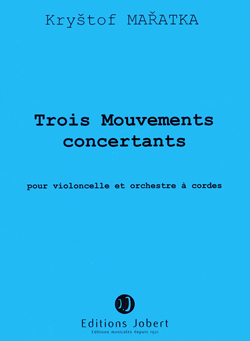THREE CONCERT MOVEMENTS
for cello and string orchestra
(1997)

Original version:
- Three Concert Movements for four cellos (1995)
Other version:
- Three concert movements for two violas, four violoncellos and double bass (2004)
Movements:
- I
- II
- III
Duration: 10’
Premiere: François Salque (violoncello), St. Petersburg Camerata, Emmanuel Leducq-Barôme (conductor)
Publisher: The Henry Lemoine Editions display more information on this work on
http://www.henry-lemoine.com/fr/catalogue/compositeur/maratka-krystof
For more information, contact:
Henry Lemoine Editions – Paris
Mrs Laurence Fauvet - Rental and purchase of score
orchestre@editions-lemoine.fr / +33 (0) 1 56 68 86 75
Jobert Editions
Henry Lemoine Editions – Paris
Mr. Benoît Walther - Promotion and distribution service
bwalther@editions-lemoine.fr / +33 (0) 1 56 68 86 74
Jobert Editions
Recording:
Listen to the version for four violoncellos
Extract from the score:
Notes on the work:
Originally, this work was written in 1995 for a quartet of violoncellos (a solo violoncello accompanied by three others). The version with string orchestra was made by the composer two years later.
An uncertain quiver of tremolos opens the first movement. At no time does this rustling of the strings suggest the series of contrasting atmospheres that will constitute the first ten pages of the score. These are indeed based on a succession of melodious and nostalgic phrases alternating with more rhythmically marked and more incisive sections. During these differentiated episodes, the strings accompany the soloist thanks to sound effects (tremolos, harmonic sounds and sul ponticello...), rhythms or characteristic intervals, without however intervening directly in his melodic universe. The second movement starts abruptly with a fiery cadenza of the solo violoncello. The effect of glissando on the strings that punctuates this recitative returns episodically during the infernal race in repeated notes that constitutes this part. Played attacca, the third movement returns to the nostalgic atmosphere of the first. In a much shorter time, the research on colours and timbres (playing sul ponticello, col legno, con sordino...) is more pronounced.

